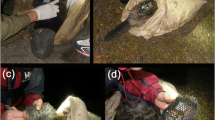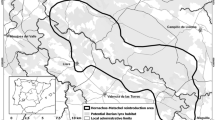Abstract
We observed and recorded the behaviours of gibbons undergoing rehabilitation, before and after release, to document the behavioural and social changes of gibbons in the rehabilitation program and develop criteria for determining the suitability of a pair of gibbons for release. Hylobates albibarbis were observed at the Kalaweit Gibbon Rehabilitation Project in Kalimantan, Indonesia. Data were collected on animals both pre- and post-release and on wild gibbons for comparison. Data presented here show that reintroduced gibbons are capable of surviving without human intervention. In addition, their behaviour is similar to that of wild gibbons in terms of activity budgets, position in the canopy, body posture, pair association (PA) and diet. Prior to this study, no attempt has been made to quantify the rehabilitation process for gibbons, and rehabilitation project personnel require data reporting all aspects of a release so that improvements can be made. It is important to report these data for the benefit of future releases. Criteria, based on the behaviour of wild gibbons, are proposed to assist rehabilitation centers in assessing the suitability of gibbon pairs for release.

Similar content being viewed by others
Abbreviations
- PA:
-
Pair association i.e., the distance between the gibbons
References
Altmann J (1974) Observational study of behaviour: sampling methods. Behaviour 49:227–265
Atkinson MW (1997) New perspectives on wildlife rehabilitation. Zoo Biol 16:355–357
Bartlett TQ (2003) Intragroup and intergroup social interactions in white-handed gibbons. Int J Primatol 24(2):239–259
Cayford J, Percival S (1992) Born captive, die free. New Sci 8:29–33
Cheyne SM (2004) Assessing rehabilitation and reintroduction of captive-raised gibbons in Indonesia. University of Cambridge, Cambridge. PhD Thesis
Cheyne SM (2007) Unusual behaviour of captive-raised gibbons: implications for welfare. Primates 47(4):322–326
Cheyne SM (in press) The role of reintroduction in gibbon conservation: opportunities and challenges. In: Lappan SM, Whittaker DL, Geissmann T (eds) The gibbons: new perspectives on small ape socioecology and population biology. Springer, New York
Cheyne SM, Brulé A (2004) Adaptation of a captive-raised gibbon to the wild. Folia Primatol 75(1):37–39
Cheyne SM, Chivers DJ, Sugardjito J (2005) Proposed guidelines for gibbon rehabilitation. http://www.iucnsscrsg.org/pages/1/index.htm, IUCN/SSC Reintroduction Specialist Group. http://www.iucnsscrsg.org/pages/1/index.htm
Cheyne SM, Chivers DJ, Sugardjito J (2006) Wildlife reintroduction: considerations of habitat quality at the release site. BMC Ecol. http://www.biomedcentral.com/1472–6785/6/5
Chivers DJ (1978) Sexual behaviour of wild siamang.In: Chivers DJ, Herbert J (eds) Recent advances in primatology, vol 1. Academic Press, London, pp 609–610
Chivers DJ (1991) Guidelines for reintroductions: procedures and problems. Symp Zool Soc Lond 62:89–99
Eudey A (1992) Captive gibbons in Thailand and the option of reintroduction to the wild. Primate Conserv 12–13:34–40
Fleagle JG (1976) Locomotion and posture of the Malayan siamang and implications for hominid evolution. Folia Primatol 26(4):245–269
Gadsby L (2002) Preparing for reintroduction: 10 years of planning for drills in Nigeria. Reintroduction News 21(Primate Issue):20–23
Gittins SP (1983) Use of the forest canopy by the agile gibbon. Folia Primatol 40:134–144
Griffith B, Michael Scott J, Carpenter JW, Reed C (1989) Translocation as a species conservation tool. Science 245:477–480
Grundmann E, Didier S (2000) Adaptation of orphaned chimpanzees (Pan troglodytes troglodytes) and orang-utans (Pongo pygmaeus) to reintroduction to the forest: activity budgets and feeding behaviour. Folia Primatol 71:195 (abstract)
IUCN/SSC (2002) Guidelines for non-human primate reintroductions. IUCN/SSC Reintroduction Specialist Group
Jarvie JK, Ermayanti , Mahyar U, Church A, Islmail (1998) The habitats and flora of Bukit Baka-Bukit Raya National Park. Trop Biodivers 5(1):11–56
Kierulff MCM (2000) Ecology and behaviour of translocated groups of golden lion tamarins Leontopithicus rosalia. University of Cambridge. PhD Thesis
Kleiman DG (1989) Reintroduction of captive mammals for conservation: guidelines for reintroducing endangered animals into the wild. Bioscience 39:152–161
MacKinnon J, MacKinnon K (1984) Territory, monogamy and song in gibbons and tarsiers. In: Preuschoft H, Chivers DJ, Brockelman WY, Creel N (eds) The lesser apes: evolutionary and behavioural biology. Edinburgh University Press, Edinburgh, pp 291–297
Mason WA, Berkson G (1975) Effects of maternal mobility on the development of rocking and other behaviours in rhesus monkeys: a study with artificial mothers. Dev Psychobiol 8:197–211
Nooteboom HP (1987) Vegetation and flora. In: Report of the 1982–1983 Bukit Raya Expedition. Leiden, The Netherland, Rijksherbarium
Peters H (1995) Orang-utan reintroduction? Development, use and evaluation of a new method: reintroduction. University of Gronigen, the Netherlands. MSc Thesis
Raemaekers JJ, Raemaekers PM (1984) The ooaa duet of the gibbon (Hylobates lar): a group call which triggers other groups to respond in kind. Folia Primatol 42:209–215
Siregar RSE, Kyes RC, Smits WTM, Russon AE (1998) The orang-utan rehabilitation project at Wanariset Station, Samboja––East Kalimantan. Am J Primatol 45(2):208 (abstracts)
Stanley Price MR (1986) The reintroduction of the Arabian (Oryx leucoryx) into Oman. Int Zoo Yearb 24(25):179–188
Tenaza RR (1975) Territory and monogamy among Kloss’ gibbons (Hylobates klossii) in Siberut Island, Indonesia. Primates 24:60–80
Tingpalapong M, Watson TM, Whitmire RE, Chapple FE, Marshall JTJ (1981) Reactions of captive gibbons to natural habitat and wild conspecifics after release. Nat Hist Bull Siam Soc 29:31–40
UFAW (1992) Guidelines for the reintroduction of captive bred mammals to the wild. International Academy of Welfare Sciences. Universities Federation for Animal Welfare, 8 Hamilton Close, South Mimms, Potters Bar, Herts, EN6 3QD, UK
Viggers KL, Lindenmayer DB, Spratt DM (1993) The importance of disease in reintroduction programmes. Wildl Res 20(5):687–698
Ware D (2001) Gibbon rehabilitation and reintroduction: the problems along the road before use as a viable conservation tool. The apes: challenges for the 21st century. Chicago Zoological Society, Brookfield, pp 259–261
Acknowledgements
We would like to thank Chanee (Aurelién Brulé), the director of the Kalaweit Project, and all Kalaweit staff who helped with data collection. Also thanks to LIPI, the Indonesian Institute of Science for permission to work in Kalimantan. We also thank Mark E. Harrison and Dawn Burnham for helpful comments on earlier versions of this manuscript. Funding for Susan M. Cheyne was provided by The Gibbon Foundation, the C.K. Marr Educational Trust and Downing College, Cambridge.
Author information
Authors and Affiliations
Corresponding author
Rights and permissions
About this article
Cite this article
Cheyne, S.M., Chivers, D.J. & Sugardjito, J. Biology and behaviour of reintroduced gibbons. Biodivers Conserv 17, 1741–1751 (2008). https://doi.org/10.1007/s10531-008-9378-4
Received:
Accepted:
Published:
Issue Date:
DOI: https://doi.org/10.1007/s10531-008-9378-4




